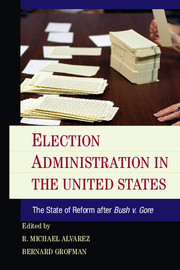Book contents
- Frontmatter
- Contents
- List of Contributors
- Foreword
- Acknowledgments
- Editors’ Introduction
- Part I Bush v. Gore in Perspective
- Part II What Has Changed since Bush v. Gore?
- Part III Remaining Challenges
- 8 The Evolution (or Not) of Ballot Design Ten Years after Bush v. Gore
- 9 Poll Workers and Polling Places
- 10 Resolving Voter Registration Problems
- 11 Felon Disenfranchisement after Bush v. Gore
- Epilogue
- References
- Index
9 - Poll Workers and Polling Places
Published online by Cambridge University Press: 05 October 2014
- Frontmatter
- Contents
- List of Contributors
- Foreword
- Acknowledgments
- Editors’ Introduction
- Part I Bush v. Gore in Perspective
- Part II What Has Changed since Bush v. Gore?
- Part III Remaining Challenges
- 8 The Evolution (or Not) of Ballot Design Ten Years after Bush v. Gore
- 9 Poll Workers and Polling Places
- 10 Resolving Voter Registration Problems
- 11 Felon Disenfranchisement after Bush v. Gore
- Epilogue
- References
- Index
Summary
Introduction
In the year after the 2000 presidential election debacle in Florida, there was a sharp focus by many organizations, commissions, and interest groups to determine how to address the problems associated with ensuring that the events of November 2000 did not occur again (e.g., Caltech/MIT Voting Technology Project, 2001; Carter and Ford, 2002). In general, these organizations considered issues related to voting technologies and voter registration. The Florida recount illustrated that it can be difficult, if not impossible, to determine how to count certain ballots, especially when the intent of the voter is not discernable from the marks on the ballot. Therefore, there was great interest after this experience in determining how to design a voting system that was easy to use and that accurately captured voter intent. It was also clear, based on the events in Florida and in other states, that many voters had never been able to get to the point of being able to mark – or mismark! – a ballot because problems with the voter registration system had not allowed them to be authenticated as valid voters.
Not surprising, election reforms passed in 2001 and 2002 tended to focus on solving these two technology problems. The Help America Vote Act (HAVA) focused most of its funding and reforms on modernizing voter registration systems by creating statewide implementations and procedures for addressing problems with voter registration through provisional voting requirements and on modernizing voting systems by banning punch card voting in federal elections and requiring the adoption of new voting systems that were auditable and that provided users with feedback regarding any errors they might have made in voting.
- Type
- Chapter
- Information
- Election Administration in the United StatesThe State of Reform after Bush v. Gore, pp. 175 - 185Publisher: Cambridge University PressPrint publication year: 2014
- 2
- Cited by

